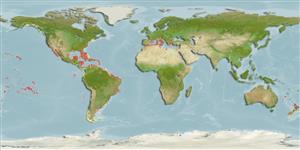Common names from other countries
Classification / Names / Names
Namen | Synonyme | Catalog of Fishes (gen., sp.) | ITIS | CoL | WoRMS
Environment: milieu / climate zone / depth range / distribution range
Ökologie
Benthopelagisch; tiefenbereich 0 - 20 m (Ref. 116114). Subtropical
Eastern Central Pacific, Western Central Atlantic and the Mediterranean.
Length at first maturity / Size / Gewicht / Alter
Maturity: Lm ? range ? - ? cm Max length : 4.0 cm H Männchen/unbestimmt; (Ref. 2376)
Stings are painful; second most important stinging jellyfish on the southcoast of Italy; in the coast of Denia (Western Mediterranean Sea), summer of 2008, it showed an unusual high density and stung as many as 185 people d-1 (Ref. 116819). Neritic (Ref. 116114). Inhabits near shore, mangrove channels, and kelp forests (Ref. 1028). Polyps were once located attached to bivalve shells in a mangrove habitat in Puerto Rico, suggesting estuarine polyps (Ref. 116835). Medusae are associated with sandy beach with Posidonia oceanica meadows (Ref. 116819). Pathogenic (Ref. 116114). Mainly feeds on copepods, mysids and gammarids (Ref. 116521). Temperature is the main factor which affects its spatio-temporal abundance along the SW Mediterranean; other variables were low salinity and high coastal productivity (chl a and phosphate) (Ref. 116819).
Cairns, S.D., D.R. Calder, A. Brinckmann-Voss, C.B. Castro, D.G. Fautin, P.R. Pugh, C.E. Mills, W.C. Jaap, M.N. Arai, S.H.D. Haddock and D.M. Opresko. 2003. (Ref. 1663)
IUCN Rote Liste Status (Ref. 130435)
CITES Status (Ref. 108899)
Not Evaluated
Not Evaluated
Bedrohung für Menschen
Harmless
Nutzung durch Menschen
| FishSource |
Tools
Mehr Information
NamenSynonymeRäuberFortpflanzungGeschlechtsreifeAblaichenFecundityEierEientwicklung
Alter/Größe
Wachstum
Länge-Gewicht
Länge-Länge
Morphologie
Larven
Dichte
Internet Quellen
Estimates based on models
Verwundbarkeit
Low vulnerability (10 of 100).
Preiskategorie
Unknown.
